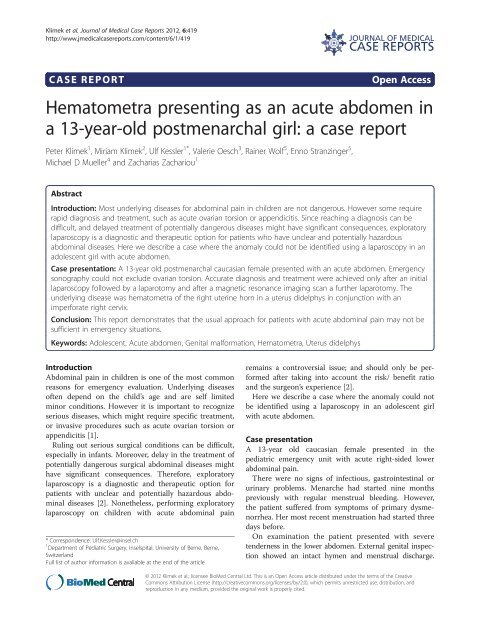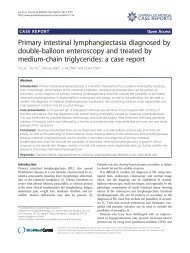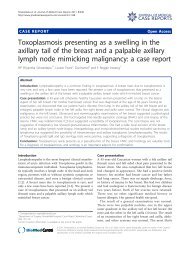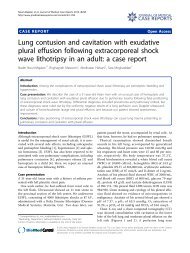PDF - Journal of Medical Case Reports
PDF - Journal of Medical Case Reports
PDF - Journal of Medical Case Reports
You also want an ePaper? Increase the reach of your titles
YUMPU automatically turns print PDFs into web optimized ePapers that Google loves.
Klimek et al. <strong>Journal</strong> <strong>of</strong> <strong>Medical</strong> <strong>Case</strong> <strong>Reports</strong> 2012, 6:419<br />
http://www.jmedicalcasereports.com/content/6/1/419<br />
JOURNAL OF MEDICAL<br />
CASE REPORTS<br />
CASE REPORT<br />
Open Access<br />
Hematometra presenting as an acute abdomen in<br />
a 13-year-old postmenarchal girl: a case report<br />
Peter Klimek 1 , Miriam Klimek 2 , Ulf Kessler 1* , Valerie Oesch 3 , Rainer Wolf 5 , Enno Stranzinger 5 ,<br />
Michael D Mueller 4 and Zacharias Zachariou 1<br />
Abstract<br />
Introduction: Most underlying diseases for abdominal pain in children are not dangerous. However some require<br />
rapid diagnosis and treatment, such as acute ovarian torsion or appendicitis. Since reaching a diagnosis can be<br />
difficult, and delayed treatment <strong>of</strong> potentially dangerous diseases might have significant consequences, exploratory<br />
laparoscopy is a diagnostic and therapeutic option for patients who have unclear and potentially hazardous<br />
abdominal diseases. Here we describe a case where the anomaly could not be identified using a laparoscopy in an<br />
adolescent girl with acute abdomen.<br />
<strong>Case</strong> presentation: A 13-year old postmenarchal caucasian female presented with an acute abdomen. Emergency<br />
sonography could not exclude ovarian torsion. Accurate diagnosis and treatment were achieved only after an initial<br />
laparoscopy followed by a laparotomy and after a magnetic resonance imaging scan a further laparotomy. The<br />
underlying disease was hematometra <strong>of</strong> the right uterine horn in a uterus didelphys in conjunction with an<br />
imperforate right cervix.<br />
Conclusion: This report demonstrates that the usual approach for patients with acute abdominal pain may not be<br />
sufficient in emergency situations.<br />
Keywords: Adolescent, Acute abdomen, Genital malformation, Hematometra, Uterus didelphys<br />
Introduction<br />
Abdominal pain in children is one <strong>of</strong> the most common<br />
reasons for emergency evaluation. Underlying diseases<br />
<strong>of</strong>ten depend on the child’s age and are self limited<br />
minor conditions. However it is important to recognize<br />
serious diseases, which might require specific treatment,<br />
or invasive procedures such as acute ovarian torsion or<br />
appendicitis [1].<br />
Ruling out serious surgical conditions can be difficult,<br />
especially in infants. Moreover, delay in the treatment <strong>of</strong><br />
potentially dangerous surgical abdominal diseases might<br />
have significant consequences. Therefore, exploratory<br />
laparoscopy is a diagnostic and therapeutic option for<br />
patients with unclear and potentially hazardous abdominal<br />
diseases [2]. Nonetheless, performing exploratory<br />
laparoscopy on children with acute abdominal pain<br />
* Correspondence: Ulf.Kessler@insel.ch<br />
1 Department <strong>of</strong> Pediatric Surgery, Inselspital, University <strong>of</strong> Berne, Berne,<br />
Switzerland<br />
Full list <strong>of</strong> author information is available at the end <strong>of</strong> the article<br />
remains a controversial issue; and should only be performed<br />
after taking into account the risk/ benefit ratio<br />
and the surgeon’s experience [2].<br />
Here we describe a case where the anomaly could not<br />
be identified using a laparoscopy in an adolescent girl<br />
with acute abdomen.<br />
<strong>Case</strong> presentation<br />
A 13-year old caucasian female presented in the<br />
pediatric emergency unit with acute right-sided lower<br />
abdominal pain.<br />
There were no signs <strong>of</strong> infectious, gastrointestinal or<br />
urinary problems. Menarche had started nine months<br />
previously with regular menstrual bleeding. However,<br />
the patient suffered from symptoms <strong>of</strong> primary dysmenorrhea.<br />
Her most recent menstruation had started three<br />
days before.<br />
On examination the patient presented with severe<br />
tenderness in the lower abdomen. External genital inspection<br />
showed an intact hymen and menstrual discharge.<br />
© 2012 Klimek et al.; licensee BioMed Central Ltd. This is an Open Access article distributed under the terms <strong>of</strong> the Creative<br />
Commons Attribution License (http://creativecommons.org/licenses/by/2.0), which permits unrestricted use, distribution, and<br />
reproduction in any medium, provided the original work is properly cited.
Klimek et al. <strong>Journal</strong> <strong>of</strong> <strong>Medical</strong> <strong>Case</strong> <strong>Reports</strong> 2012, 6:419 Page 2 <strong>of</strong> 3<br />
http://www.jmedicalcasereports.com/content/6/1/419<br />
Blood and urine tests were normal. Transabdominal ultrasound<br />
with a low-filled bladder detected an 8cm × 6.5cm<br />
hypoechoic mass in the right iliac fossa without perfusion,<br />
interpreted as a uterine malformation, a hematocolpos or<br />
an ovarian torsion.<br />
Due to the risk <strong>of</strong> an underlying ovarian torsion,<br />
the patient was taken to theater for vaginoscopy<br />
under anesthesia and, in the absence <strong>of</strong> any pathologic<br />
findings, for exploratory laparoscopy and, if necessary,<br />
laparotomy. Vaginoscopy showed a normal<br />
vaginal vault and a single cervix. Ovarian torsion<br />
could not be excluded by laparoscopy due to rightsided<br />
peritubal adhesions. Following a Pfannenstiel<br />
laparotomy, a bicornuate uterus with a blood- filled<br />
right uterine horn was diagnosed. The ovaries and<br />
tubes were normal. The right uterine hematometra<br />
was transabdominally drained.<br />
Postoperative magnetic resonance imaging (MRI)<br />
was performed to clearly visualize the anatomic condition.<br />
It confirmed two separate uterocervical cavities<br />
without communication <strong>of</strong> the right cervix to<br />
the vagina (Figure 1). Right-sided kidney aplasia was<br />
notedbyultrasoundandMRI.<br />
The continuity between the right uterus and the vagina<br />
was reconstructed one week later. The girl recovered fully<br />
and had normal menstruation without dysmenorrhea when<br />
we saw her at follow-up, six months later.<br />
Discussion<br />
This patient illustrates the challenges <strong>of</strong> diagnosis and<br />
treatment <strong>of</strong> uterine malformations. The presence <strong>of</strong> acute<br />
abdominal pain required us to intervene immediately.<br />
One reason why an internal genital malformation<br />
could not be diagnosed earlier were the anamnesis <strong>of</strong><br />
menarchal onset with regular bleeding for nine months,<br />
as well as the physical examination showing severe tenderness<br />
in the lower abdomen together with a regular<br />
hymen.<br />
Since the patient presented with an acute abdomen,<br />
and ovarian torsion was a likely possibility following<br />
transabdominal ultrasound, we took the patient to theater<br />
for vaginoscopy, laparoscopy and finally laparotomy.<br />
Could more accurate diagnostic imaging have prevented<br />
the emergency intervention? We routinely use<br />
transabdominal ultrasound with, if possible, a fully distended<br />
urine bladder as first imaging choice for cases<br />
<strong>of</strong> unclear abdominal pain in girls [3]. Transvaginal<br />
ultrasound might have revealed the underlying disease<br />
in our patient, but is not recommended in non-sexually<br />
active girls.<br />
MRI <strong>of</strong> the pelvis is the imaging <strong>of</strong> choice after ultrasound<br />
examination if uterine malformation is a possibility<br />
[4]. In our institution the access to abdominal MRI in<br />
emergency situations is limited.<br />
For suspected ovarian torsion immediate care is required<br />
and surgical detorsion within four hours after onset <strong>of</strong><br />
symptoms might reduces tissue damage [5,6]. Taken<br />
altogether, we believe that we made the correct decision.<br />
How can renal agenesis be interpreted in the present<br />
case? Uterus didelphys is caused by an incomplete fusion<br />
<strong>of</strong> the Mullerian duct system. In 36% <strong>of</strong> all cases, Mullerian<br />
anomalies are associated with other structural abnormalities;<br />
most <strong>of</strong> them being renal malformations because <strong>of</strong><br />
the concomitant embryologic development [7].<br />
3<br />
Figure 1 Magnetic resonance image T2-weighted; 1: right horn <strong>of</strong> the uterus with drainage tube in place, 2: Left horn <strong>of</strong> the uterus,<br />
3: Illustration <strong>of</strong> the configuration <strong>of</strong> the uterus in the present case.
Klimek et al. <strong>Journal</strong> <strong>of</strong> <strong>Medical</strong> <strong>Case</strong> <strong>Reports</strong> 2012, 6:419 Page 3 <strong>of</strong> 3<br />
http://www.jmedicalcasereports.com/content/6/1/419<br />
The most widely-accepted classification <strong>of</strong> uterine<br />
malformations from the American Fertility Society, does<br />
not take into account the frequently associated vaginal,<br />
cervical or urological anomalies [8-10]. The renal and<br />
genital anomalies found in our patient could be more<br />
precisely described by another classification from Oppelt<br />
et al. as V0 C2a U2 A0 MR [11].<br />
Conclusion<br />
This report demonstrates the challenges and pitfalls in<br />
diagnosis and treatment <strong>of</strong> postmenarchal girls with<br />
acute abdominal pain, and shows that the usual approach<br />
to patients with acute abdominal pain may not<br />
be sufficient in emergency situations. Nonetheless diagnostic<br />
laparoscopy remains the standard emergency approach<br />
for patients with potentially hazardous acute<br />
abdominal pain. Judicious use <strong>of</strong> MRI in adolescent girls<br />
may help to obviate the need for transvaginal ultrasonography<br />
in circumstances where the diagnosis is difficult<br />
to establish.<br />
Consent<br />
Written informed consent was obtained from the<br />
patient’s legal guardian for publication <strong>of</strong> this manuscript<br />
and accompanying images. A copy <strong>of</strong> the written<br />
consent is available for review by the Editor-in-Chief <strong>of</strong><br />
this journal.<br />
Competing interests<br />
The authors declare that they have no competing interests.<br />
del Trauma (SICUT), Società Italiana di Chirurgia nell’Ospedalità Privata<br />
(SICOP), and the European Association for Endoscopic Surgery (EAES). Surg<br />
Endosc 2012, 26:2134–2164.<br />
3. Stranzinger E, Strouse PJ: Ultrasound <strong>of</strong> the pediatric female pelvis. Semin<br />
Ultrasound CT MR 2008, 29:98–113.<br />
4. Marten K, Vosshenrich R, Funke M, Obenauer S, Baum F, Grabbe E: MRI in the<br />
evaluation <strong>of</strong> Mullerian duct anomalies. Clin Imaging 2003, 27:346–350.<br />
5. Taskin O, Birincioglu M, Aydin A, Buhur A, Burak F, Yilmaz I, Wheeler JM: The<br />
effects <strong>of</strong> twisted ischaemic adnexa managed by detorsion on ovarian<br />
viability and histology: an ischaemia-reperfusion rodent model. Hum<br />
Reprod 1998, 13:2823–2827.<br />
6. Growdon WB, Laufer MR: Ovarian and fallopian tube torsion. InUptodate.<br />
Edited by Basow DS. Waltham, MA: UpToDate; 2010.<br />
7. Oppelt P, von Have M, Paulsen M, Strissel PL, Strick R, Brucker S, Wallwiener D,<br />
Beckmann MW: Female genital malformations and their associated<br />
abnormalities. Fertil Steril 2007, 87:335–342.<br />
8. The American Fertility Society classifications <strong>of</strong> adnexal adhesions, distal<br />
tubal obstruction, tubal occlusion secondary to tubal ligation, tubal<br />
pregnancies, müllerian anomalies and intrauterine adhesions. Fertil Steril<br />
1988, 49:944–955.<br />
9. Acién P, Acién M, Sánchez-Ferrer ML: Müllerian anomalies “without a<br />
classification”: from the didelphys-unicollis uterus to the bicervical<br />
uterus with or without septate vagina. Fertil Steril 2009, 91:2369–2375.<br />
10. Gubbini G, Di Spiezio Sardo A, Nascetti D, Marra E, Spinelli M, Greco E,<br />
Casadio P, Nappi C: New outpatient subclassification system for American<br />
Fertility Society Classes V and VI uterine anomalies. J Minim Invasive<br />
Gynecol 2009, 16:554–561.<br />
11. Oppelt P, Renner SP, Brucker S, Strissel PL, Strick R, Oppelt PG, Doerr HG,<br />
Schott GE, Hucke J, Wallwiener D, Beckmann MW: The VCUAM-<br />
Classification (Vagina Cervix Uterus Adnex-associated Malformation)<br />
classification: a new classification for genital malformations. Fertil Steril<br />
2005, 84:1493–1497.<br />
doi:10.1186/1752-1947-6-419<br />
Cite this article as: Klimek et al.: Hematometra presenting as an acute<br />
abdomen in a 13-year-old postmenarchal girl: a case report. <strong>Journal</strong> <strong>of</strong><br />
<strong>Medical</strong> <strong>Case</strong> <strong>Reports</strong> 2012 6:419.<br />
Authors’ contributions<br />
All authors analyzed and interpreted the patient history, data, images and<br />
clinical findings. PK, MK, and UK wrote the manuscript. All authors read and<br />
approved the final manuscript.<br />
Acknowledgements<br />
The authors thank Michael Howell and Robert Frijs for their help in<br />
manuscript editing.<br />
Author details<br />
1 Department <strong>of</strong> Pediatric Surgery, Inselspital, University <strong>of</strong> Berne, Berne,<br />
Switzerland. 2 Department <strong>of</strong> Obstetrics and Gynecology, Regionalspital<br />
Emmental, Burgdorf, Switzerland. 3 Department <strong>of</strong> Pediatric Surgery,<br />
Kantonsspital Aarau, Aarau, Switzerland. 4 Department <strong>of</strong> Obstetrics and<br />
Gynecology, Inselspital, University <strong>of</strong> Berne, Berne, Switzerland. 5 Department<br />
<strong>of</strong> Diagnostic, Interventional and Pediatric Radiology, Inselspital, University <strong>of</strong><br />
Berne, Berne, Switzerland.<br />
Received: 18 July 2012 Accepted: 6 November 2012<br />
Published: 12 December 2012<br />
References<br />
1. D’Agostino J: Common abdominal emergencies in children. Emerg Med<br />
Clin North Am 2002, 20:139–153.<br />
2. Agresta F, Ansaloni L, Baiocchi GL, Bergamini C, Campanile FC, Carlucci M,<br />
Cocorullo G, Corradi A, Franzato B, Lupo M, Mandalà V, Mirabella A, Pernazza G,<br />
PiccoliM,StaudacherC,VettorettoN,ZagoM,LettieriE,LevatiA,PietriniD,<br />
ScaglioneM,DeMasiS,DePlacidoG,FrancucciM,RasiM,FingerhutA,Uranüs<br />
S, Garattini S: Laparoscopic approach to acute abdomen from the Consensus<br />
Development onference <strong>of</strong> the Società Italiana di Chirurgia Endoscopica e<br />
nuove tecnologie (SICE), Associazione Chirurghi Ospedalieri Italiani (ACOI),<br />
Società Italiana di Chirurgia (SIC), Società Italiana di Chirurgia d’Urgenza e<br />
Submit your next manuscript to BioMed Central<br />
and take full advantage <strong>of</strong>:<br />
• Convenient online submission<br />
• Thorough peer review<br />
• No space constraints or color figure charges<br />
• Immediate publication on acceptance<br />
• Inclusion in PubMed, CAS, Scopus and Google Scholar<br />
• Research which is freely available for redistribution<br />
Submit your manuscript at<br />
www.biomedcentral.com/submit








